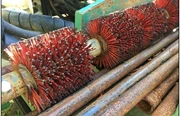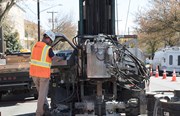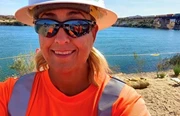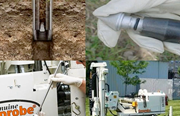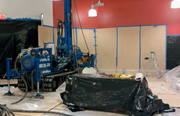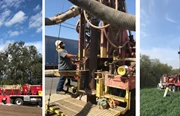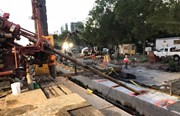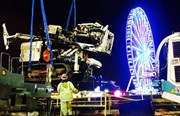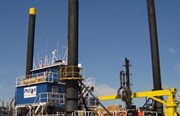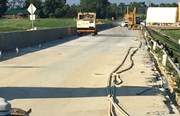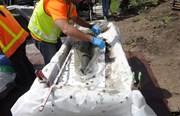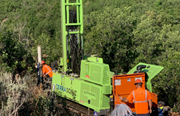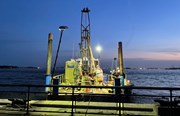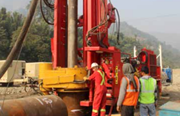- Bill Poupis
Within the drilling industry, the concept of limited access encompasses a diverse range of spatial, ventilation, terrain, or operational limitations. It’s often referred to as restricted access. When encountered during drilling operations, these constraints necessitate the implementation of specialized adaptations to drill rigs. Although limited access may initially bring to mind urban environments, it is important to recognize that drillers regularly encounter these challenges on rural job sites and even in marine settings.
In this blog, drilling expert Bill Poupis explains typical restricted access site conditions how limited access drill rigs get the job done.
Limited Access Site Conditions
Historically, limited access drilling has been associated with environmental drilling applications. But as we’ve seen at ADT, there is a significant demand for limited access operations in geotechnical drilling, especially in a hot real estate market. Geotechnical data is required for building design and permitting. Limited access drilling operations can retrieve the necessary geotechnical data prior to tear down of an existing building which shortens the project life cycle of tear down, permitting, design, construction, and property sale.
Limited access rigs are especially effective in the following conditions.
- Small Geographic Footprint: A drill site that cannot accommodate a full-size rig with support vehicles and crew. This is often the case in crowded urban settings, as discussed in our previous blog on bioswale installation under New York City’s Green Infrastructure Plan.
- Low Clearance: A low overhead clearance requires a drill rig with a short tower. Typically, a clearance under 15 feet warrants consideration of limited access options.
- Ventilation: Air quality is a major concern when drilling operations move indoors. Proper exhaust ventilation of diesel or propane equipment or alternative engine type is required to protect the crew, other on-site personnel, or even the workforce of an active facility.
- Surface Restraints: Atypical surfaces may warrant specialty equipment. Drilling over the water, on uneven surfaces, or off-road are common situations easily managed with limited access equipment.
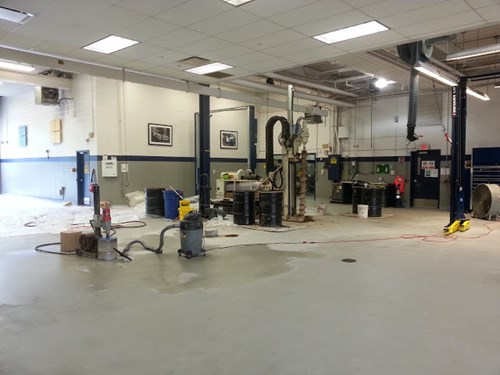
Limited Access Drilling Options Not Restricted to Sonic
Limited access drill rigs are not technology specific. There’s a wide range of options for direct push, auger, rotary, and sonic drilling methods. With so many drilling equipment options, how do you choose the right rig? It all comes down to the specific site restraints and your project goals.
As we mentioned previously a diverse range of conditions necessitate the use of specialty drill rigs. One prominent category is low clearance rigs, which come in various drilling technologies and incorporate features tailored for limited access environments. These rigs often include track or skid mounts, allowing for maneuverability, as well as other adaptations such as on-site assembly and electric motors.
Noteworthy options within the low-clearance drilling rigs include track-mounted sonic rigs measuring under 14 feet, hollow stem auger rigs with clearance below 12.5 feet, and electric rigs with a clearance of less than 10 feet. It is important to note that no single rig type serves as the universal solution for limited access challenges, as the specific circumstances and requirements vary significantly.
For scenarios involving restricted entry and space constraints, an exceptional indoor drilling option exists in the form of the FORDIA/EXPLO 220/mud rig. This aluminum rig is designed with clearance below 8 feet, resembling a real-life Lego set in its versatility. To navigate the limitations, the crew disassembles the rig, relocates the components to the desired drilling site, and then reassembles it, facilitating drilling operations within confined spaces. This innovative approach proves invaluable when traditional drilling methods are impractical or infeasible due to the restricted nature of the environment.
Another prevalent approach to address limited access challenges involves modifying existing rig platforms to accommodate alternative drilling technologies. This solution offers flexibility in adapting to diverse drilling needs. For instance, the Geoprobe 420M direct push platform has been successfully modified to incorporate mud rotary and air hammer capabilities. This adaptation enables the platform to perform a wide range of environmental well installation and sampling tasks.
In situations requiring drilling over bodies of water, employing a barge becomes a practical solution for both environmental and geotechnical purposes. Barges come in various sizes and capacities, ensuring that rigs and crews of nearly any scale can be mobilized for efficient operations. This approach expands the possibilities of drilling in marine environments, where conventional land-based equipment may encounter significant limitations.
When faced with situations where direct access to a building is unattainable, an alternative technique known as angle drilling proves beneficial. Sonic, auger, and direct push rigs, whether truck or track mounted, can be utilized to perform angle drilling. By employing this approach, drilling operations can circumvent obstacles and access subsurface targets by drilling at specific angles.
Safety Knows No Bounds
Limited access drilling brings a unique set of safety concerns. First and foremost is the well-being of the operator and crew. Ensuring adequate space for the crew to move around safely as well as maneuvering the rig during operations is paramount to maintaining our safety standards. Some restricted track-mounted rigs are operated with a radio or tethered remote, allowing the operator to stand clear of the rig while setting up on the drill location.
There are two primary concerns with indoor drilling - ventilation and temperature. Engineering controls on the rig are necessary to ensure proper ventilation of diesel or propane rigs in a confined space. Ambient temperature does impact the rig choice but does require additional health and safety precautions and work plan modifications are to protect the crews from extreme heat or cold.
The same worksite hazards of standard drilling operations are also a concern with limited access drilling. These risk factors include exposure to dust, noise, moving equipment, and slip/trip/fall. Proper health and safety training along with a properly implemented work plan (JSA) help reduce the risk of injury.
Managing Expectations
When engaging in limited access drilling, it is crucial to recognize that there are specific considerations that require additional planning and execution. While there is no inherent reason for limited access drilling to encounter difficulties, it's important to be aware of what to expect when undertaking such operations. Here are some key aspects to consider:
- Time: Limited access drilling operations inherently take more time compared to carrying out the same tasks in unrestricted conditions. This is primarily due to the need for specialty equipment and additional engineering controls. In confined spaces, the drilling crew must work with shorter lengths of casing and drill rods, which can slow down the overall progress. As a result, it is essential to allocate extra time for mobilization, demobilization, and drilling operations when planning limited access projects.
- Expense: Limited access drilling incurs additional expenses compared to drilling in unrestricted areas. The utilization of specialty equipment and the involvement of skilled operators often come at a premium price. Moreover, the slower pace of operations in confined spaces contributes to extended project durations, leading to higher overall costs. It is crucial to account for these financial considerations when budgeting for limited-access drilling projects.
- Experienced Operators: Limited access drilling requires specialized skills and expertise. To ensure successful outcomes, investing time and effort in finding an experienced drilling contractor with a proven safety record and a diverse fleet of limited-access drilling equipment is imperative. When selecting a contractor, inquire about their safety program, request project references, and assess their contingency plans for overcoming unexpected challenges such as mechanical problems, geological issues, and physical limitations at the job site. Collaborating with a reputable and experienced operator will yield long-term benefits and enhance the overall success of the limited-access drilling project.
Drillers can confidently navigate limited-access drilling by being aware of the potential challenges and taking necessary precautions. With meticulous planning, efficient resource allocation, and the expertise of experienced operators, successful outcomes can be achieved even in challenging drilling environments.
In conclusion, limited access drilling encompasses a diverse range of conditions that demand the utilization of specialized drill rigs. From small geographic footprints and low clearance requirements to ventilation concerns and surface restraints, drillers face unique challenges in various drilling environments.
Selecting the right rig for your project depends on the site restraints and project goals.
Your limited access project deserves the expertise and guidance of professionals who understand the intricacies of drilling in challenging environments. Take the next step and contact us today to unlock the full potential of your limited-access project by getting in touch with an expert.
About The Author

Bill Poupis is the Senior Vice President of Operations for the California and Northeast regions. He is a geologist and drilling expert who has worked in the industry for nearly 40 years and ensures his clients have the right people and technologies on every project. Bill oversees more than 200 employees across six locations and leads them in performing safe and high-quality work that hits project benchmarks and budgets.
Categories
- Site Remediation
- Drilling
- Careers
- Cascade Chemistries
- Safety
- Site Characterization
- Thermal
- Rotary
- Sustainability
- In Situ Stabilizaton
- High Resolution Site Characterization
- Injection
- Sonic Drilling
- Automated injection
- corporate sustainability
- case studies
- in situ thermal remediation
- Cascade Drilling
- Over Water Drilling
- In Situ Stabilization (ISS)
- ISS
- Environmental Remediation

